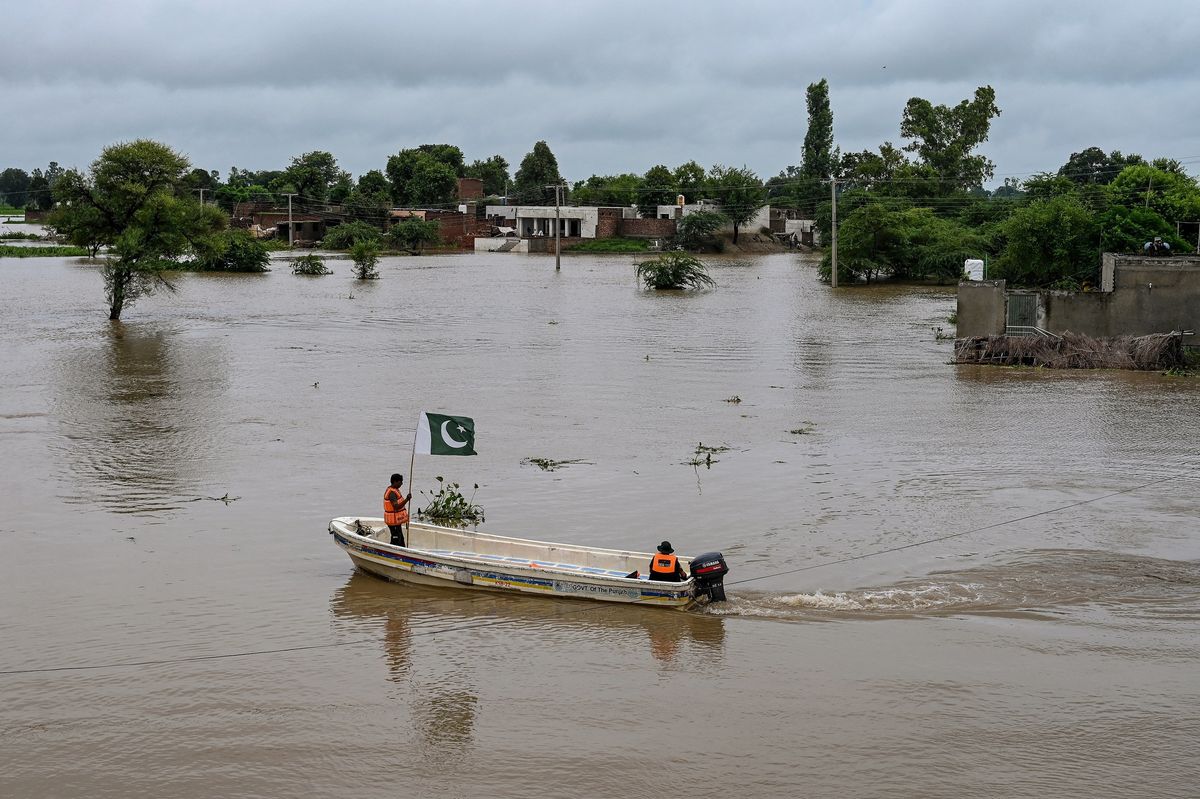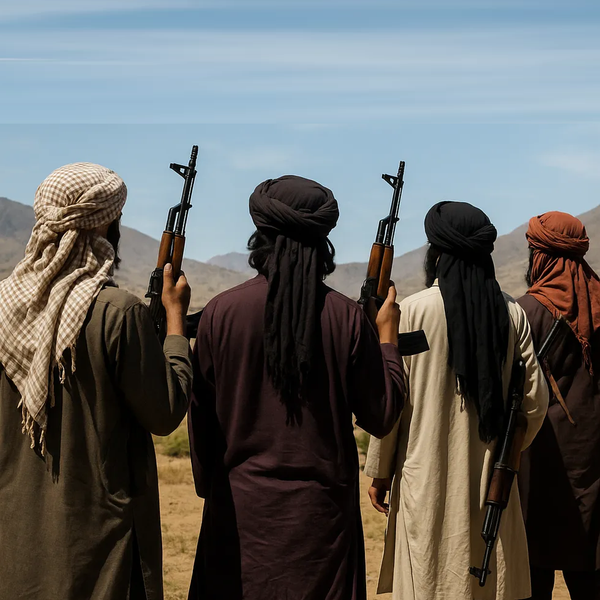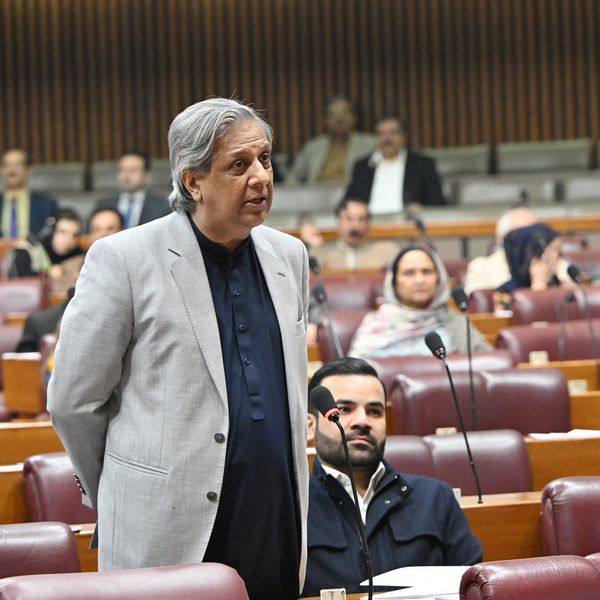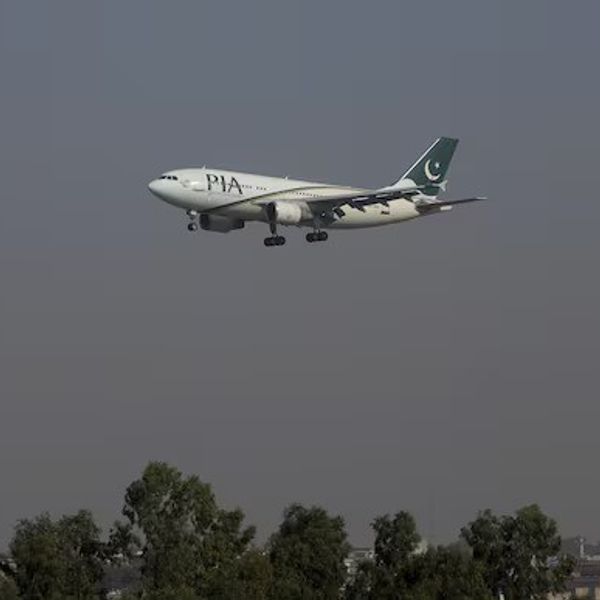Pakistan’s Punjab on high alert as flooding rivers rise and next rain spell looms
DG NDMA and DG ISPR brief on Punjab floods, highlight ongoing rescue efforts, including boat operations at Gurdwara Kartarpur Sahib
News Desk
The News Desk provides timely and factual coverage of national and international events, with an emphasis on accuracy and clarity.
Ali Hamza
Correspondent
Ali; a journalist with 3 years of experience, working in Newspaper. Worked in Field, covered Big Legal Constitutional and Political Events in Pakistan since 2022. Graduate of DePaul University, Chicago.

Rescuers patrol through floodwaters in the Haqu Wala village of Pakistan's Kasur district on August 24, 2025.
AFP
Pakistani authorities said on Monday they were taking measures to contain the threat of severe flooding in Punjab, the country’s most populous province, as heavy monsoon rains swelled rivers and another spell of rain loomed at the end of the month.
The warning comes as days of torrential downpours and upstream water flows have pushed several rivers close to dangerous levels, threatening large swathes of farmland and communities across Punjab.
The situation has been worsened by heavy rainfall in neighboring Indian-administered Kashmir, with floodwaters expected to keep rising in the coming days.
Rivers under pressure
To address mounting concerns, senior Pakistani officials held a joint press conference today to brief the media on the country’s flood preparedness and response efforts.
National Disaster Management Authority (NDMA) Chairman Lt Gen Inam Haider said the country was “entering a critical phase” of the monsoon season. “We are currently in the second-to-last spell of the monsoon rains,” he said at a press briefing, noting that Indian-administered Kashmir had experienced “over 300mm of rain near Jammu last night and more than 600mm in the eastern areas of Sialkot.”
- YouTube www.youtube.com
He said heavy rainfall across the border had triggered cloudbursts and flash floods in Indian-administered Kashmir, with floodwaters entering the Chenab, Ravi, and Sutlej rivers and flowing into Pakistan.
“In the Chenab River, water flow reached 700,000 cusecs at Marala point, though its intensity is now decreasing. Downstream from Marala, the flow reached an exceptionally high level of 10 lakh cusecs,” Haider said.
“The Ravi River is at 230,000 cusecs, and the Sutlej is carrying around 250,000 cusecs of water. Many people have already been rescued safely, but if areas like Narowal and Multan receive more rainfall, they will also come under severe pressure.”
The NDMA chief warned that another heavy spell is expected to begin on August 29 in the same areas, adding that “all relevant authorities have been placed on high alert.” He said the Indus River in lower Sindh remains normal, as do flows at Kalabagh, Chashma, and Taunsa, as well as in the Jhelum River at Mangla.
Logistics support, including 5,000 tents, has been dispatched to NDMA, and Prime Minister Shehbaz Sharif is scheduled to visit the affected areas on Thursday.
Authorities step up rescue efforts
Information Minister Ataullah Tarar said the flooding situation in three major rivers was being “closely monitored” but highlighted that the construction of settlements along riverbeds had worsened the risk. “The administration has been instructed to ensure no further construction takes place in these areas,” he said.
The military has ramped up rescue and relief operations across affected regions. “Since the onset of flooding in Khyber Pakhtunkhwa, the army has been carrying out rescue operations under the directives of the army chief,” said Inter-Services Public Relations (ISPR) Director General Lt Gen Ahmed Sharif Chaudhry. “Army aviation and other units are fully engaged. So far, 104 roads have been cleared - 100 in KP and four in Gilgit-Baltistan.”
He added that army aviation continues to operate despite severe weather conditions.
Chaudhry added that rescue boats were evacuating stranded people in Kartarpur Sahib and that aerial operations would commence once weather conditions allowed. “No post has been vacated along the working boundary and border, all positions remain fully manned, and 100% vigilance is in place,” he said.
“Two soldiers have been martyred in the line of duty, and two others have been injured.” He stressed that the Pakistan Army “stands firmly with the people of Pakistan” and is working “in complete coordination with local administrations and provincial governments to overcome this crisis.”
- YouTube www.youtube.com
Authorities said more than 150,000 people have already been moved from flood-prone areas, including nearly 35,000 who left voluntarily after earlier warnings. Relief camps with food and medicine have been established across Punjab. Videos on social media showed floodwaters inundating Gurdwara Kartarpur Sahib, a major Sikh temple near the Indian border.
Cross-border tensions add to crisis
The crisis has been further complicated by tensions with India. On Tuesday, Pakistani officials said Lahore and large swathes of Punjab faced a “very high to exceptionally high” flood risk after India opened the gates at the Thein Dam and signaled further releases from the Madhopur Dam. “These water releases have intensified the threat to Punjab,” an NDMA official said.
India’s Water Resources Ministry has not commented publicly, but Indian officials told reporters the warnings were shared with Pakistan through diplomatic channels “on humanitarian grounds,” noting that heavy rains had also caused severe flooding and casualties in Indian Punjab and Indian-administered Kashmir.
As Pakistan braces for the next monsoon wave, officials say the focus remains on saving lives. “Our priority is zero casualties,” Lt Gen Haider said. “We are prepared, but nature’s force is beyond anyone’s control.”










Comments
See what people are discussing